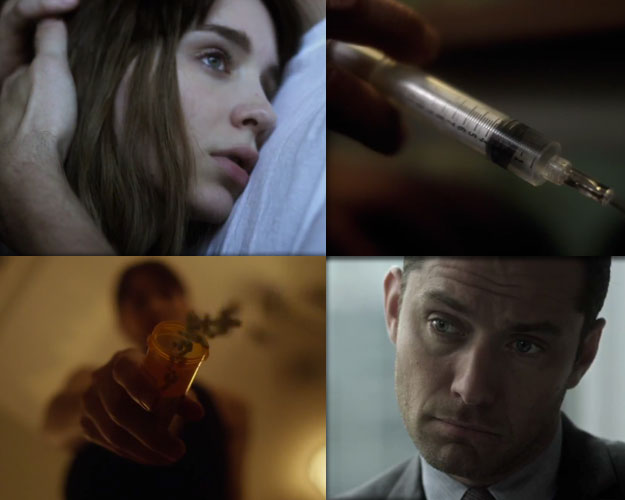
It’s scary to think that even in 2013, medicine is not an exact science. Not to shortchange the legitimate advances in medical technology and the tireless work of doctors, scientists, and other professionals, but there’s a problem that rests with the idiosyncratic nature of human pathology. This is why a seemingly innocuous cold medicine, that does no harm to 99.9% of the population, can end up killing some unfortunate outlying individual. In director Steven Soderbergh’s latest film Side Effects, he examines the relationship between the intended benefits of medicine and the dangerous unintentional results of its ingestion.
One thing that has dramatically changed health care over the last decade or so is the prevalence of online medical knowledge. Sites like WebMD have made it possible for the average person to, at least attempt to, diagnose themselves without consulting a physician. This is not the ideal scenario of course, as the credentials needed to surf the web and those necessary to practice medicine are wholly divergent, but it does put more academic information at the fingertips of the average Joe. One wonders how some iconic characters from cinema past would have been diagnosed and treated were WebMD available at the time….
Regan in The Exorcist
If you’ve seen The Exorcist, and at this point it’s hard to imagine how you couldn’t have, then you know that Regan was that sweet little girl who becomes possessed by the devil. The symptoms she exhibits include thrashing about in a rage, using foul language, and becoming physically abusive with her mother. So, of course, priests were called in to deal with her obvious supernatural malady. And yet, it has never been rare for children Regan’s age to suddenly become difficult to deal with, even monstrous. Hormones are partially at the heart of this, but the natural volatility of adolescence can be augmented by Attention Deficit Hyperactivity Disorder (ADHD). If Mrs. MacNeil were a user of WebMD, she might have delayed the call to the old priest and the young priest; opting instead for putting Regan on Ritalin and/or adding more fiber to her diet.
Kane in Alien
Just when that ugly, face-hugging alien is removed from your face, and you have convinced yourself that the worst is over, out pops a nasty little fledgling Xenomorph that turns your chest into a fruit bowl. It’s sort of bizarre to re-imagine older movies set in the distant future as to how they would have benefited from the existence of the internet, but here again it’s hard not to postulate how Kane’s treatment would have differed if he could’ve cruised the information super highway as easily as the Nostromo combed deepest space. Perhaps the crew would’ve recognized the situation as a simple case of intestinal parasite. If they had, maybe that fateful meal prior to his dramatic exit from the movie would’ve consisted of more garlic and wormwood, two things shown to be highly effective in ridding the body of parasites.
Darth Vader in the Star Wars Trilogy
In Star Wars, the galaxy is presided over by the sinister Darth Vader. In addition to being the terrifying right-hand man of the villainous Emperor, Vader was one of cinema’s most prominent asthmatics. We would later find out that his condition was caused by a rather uninspired battle with his mentor on a computer-generated lava planet, but the end result was a considerably cumbersome respirator. Were Darth to consult WebMD, perhaps he might have attempted to use corticosteroids as a controller medication as opposed to the constant, rhythmic quick relief of his noisy apparatus. At the very least, he wouldn’t have sounded like a walking iron lung.
Snake Plissken in Escape from New York
The great characters in cinema, especially action cinema, are often enigmatic; we aren’t allowed into every corner of their psyche. Snake Plissken from John Carpenter’s Escape from New York certainly qualifies on that front. From other characters, we catch passive references to his past, but he is a man of few words shrouded in mystery. One of the most mysterious facets of Snake is his eye patch. How did he lose that eye? If we may theorize, perhaps Snake suffered a scratched cornea. Granted, this is a fairly common and highly treatable condition, but given his lone wolf machismo, even if Snake had had access to WebMD he probably would have tried to remove the obstruction from his eye himself; the ensuing corneal scar claiming his vision.
Peyton Flanders in The Hand That Rocks the Cradle
1992’s The Hand that Rocks the Cradle is a hodgepodge of every woman’s worst fears. A young family hires a seemingly wonderful woman to be their live-in nanny, and it turns out that she’s got miles and miles of nefarious ulterior motives. Though not as viable a source as the DSM, WebMD does have some criteria for diagnosing mental disorders. It would appear that Rebecca De Mornay’s Peyton Flanders suffers from a histrionic personality disorder. Those suffering from this disorder are egocentric, they are excessively emotional, their need for attention makes them inappropriately sexual, and they are expertly manipulative. If that doesn’t describe Peyton, nothing does. The utilization of WebMD here would be a dubious proposition, as it would have had to be Peyton herself who looked up treatment, but if she were to do so, she’d find that psychotherapy is preferred over medication.
[Photo Credit: Open Road Films]
More:
‘Side Effects’: Rooney Mara Does Drugs, Everything Goes Horribly Wrong — EXCLUSIVE VIDEO
‘Side Effects’: Steven Soderbergh Looks to End His Career on a Sad Note — POSTER
‘Side Effects’ May Include Infidelity, Murder, and Channing Tatum — TRAILER
You Might Also Like:





